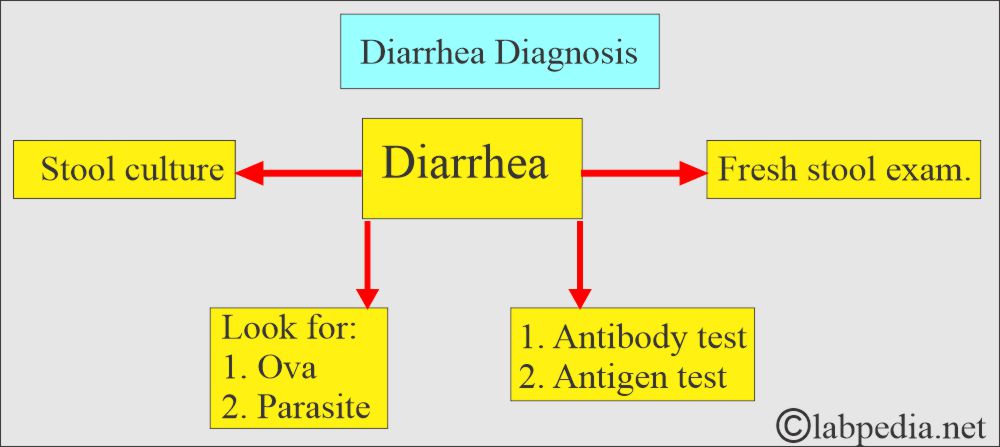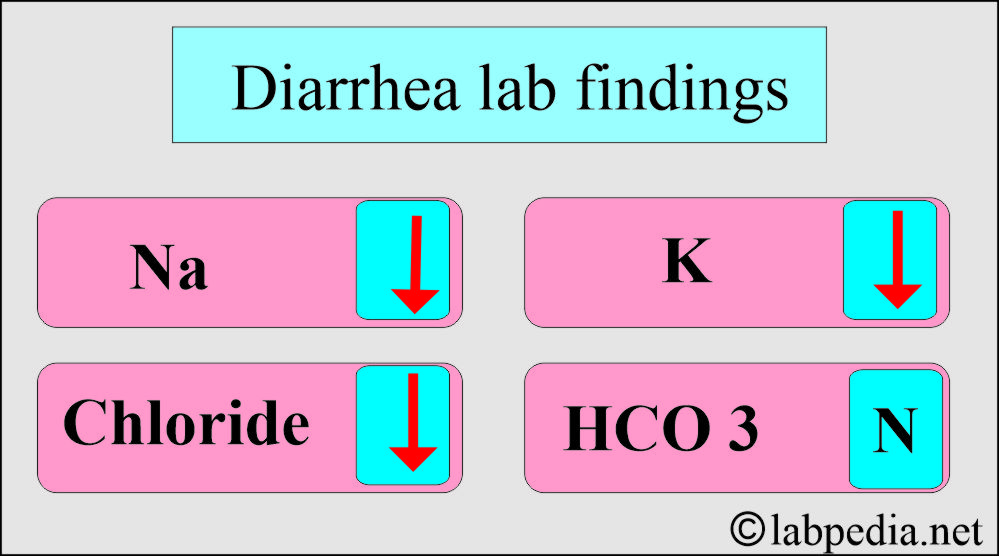Diarrhea:- Part 1 – How to diagnose Diarrhea?
How to diagnose Diarrhea?
What Sample is needed to diagnose diarrhea?
- A fresh stool sample is ideal.
- Blood may be needed for antigen and antibody testing
How will you define diarrhea?
- 3-loose stools per day characterize diarrhea and may be accompanied by the following:
- Abdominal pain.
- Nausea and vomiting.
- Fatigue.
What are the causes of Diarrhoea?
- Diarrhea may be:
- Acute.
- Chronic.
- This may be due to the following:
- Viral infections. The most common cause is retrovirus among children. Other viruses are Adenovirus, cytomegalovirus, and HIV.
- Bacterial infections are due to Salmonella, Vibrio, Campylobacter, and Yersinia.
- Other causes include toxigenic bacteria such as Staphylococcus and Bacillus cereus, Shigella, and E. Coli.
- Parasitic infestation, e.g., Giardia Lamblia and Entamoeba histolytica.
How will you discuss the pathophysiology of Diarrhea?
- Most diarrhea is due to infections.
- Age:
- Mostly, the young are susceptible due to poor health.
- Poor general health and nutrition will predispose one to diarrhea.
- Bacteria leading to diarrhea depend upon the following:
- A dose of the bacterial infection.
- Production of enterotoxin.
- It has the ability to attach to the intestinal mucosa and to invade the mucosa.
- Other factors for diarrhea are:
- Poor sanitation.
- Contaminated food and water.
- Personal hygiene, washing hands with soap after defecation, prevents the fecal-oral spread.
- Food stored at room temperature allows rapid bacterial growth and the production of toxins.
- Food stored at 4 °C cannot kill bacteria; it can only prevent their multiplication.
- Avoid keeping food at room temperature, as this leads to the rapid proliferation of the organism.
- AIDS has a prominent feature of diarrhea.
What are the types of diarrhea?
Diarrhea may be:
- Acute.
- Chronic.
Diarrhea may be:
- Watery diarrhea.
- Blood diarrhea.
- Diarrhea with a lot of mucus.
What are the causes of various types of diarrhea?
| Presentation of diarrhea | Causative agent | Source of spread | Diagnosis |
|
|
|
|
|
Intestinal parasites:
|
|
|
|
There are several enterotoxins:
|
|
|
|
|
|
|
|
Due to Enteric viruses
|
|
|
|
|
|
|
What are the causes of diarrhea, and how will you diagnose it?
| Causative agent | Source | A common source of infection | Diagnosis |
|
|
|
|
|
|
|
|
|
|
|
|
|
|
|
|
|
|
|
|
|
|
|
|
|
|
|
|
|
|
|
|
|
|
|
|
|
|
|
|
What are other types of diarrhea?
How will you define Osmotic diarrhea (Malabsorption)?
- It is defined as diarrhea with a <3 weeks to 8 weeks duration.
- It is due to increased osmotically active solutes in the stool.
- This type of diarrhea stops during fasting.
How will you define secretory diarrhea?
- It is due to abnormal electrolyte transport.
- Secretory diarrhea is caused by an increase in water and chloride secretion.
How will you define exudative diarrhea?
- There is active inflammation of the intestinal mucosa.
- Primarily due to infectious bacteria.
How will you discuss diarrhea due to motility issues?
- There is decreased motility of the small intestine.
- It may be seen in hypothyroidism, diabetes mellitus, postvagatomy, and amyloidosis.
- There may be increased motility of the small intestine.
- It may be seen in hyperthyroidism, carcinoid syndrome, and irritable bowel syndrome.
How will you discuss diarrhea due to malabsorption?
- It is due to defective digestion or absorption.
- It may be seen in lymphatic obstruction.
- In surgery, the resection of the intestine.
- G. lamblia causes impaired absorption.
Chronic diarrhea:
How will you define chronic diarrhea?
- Chronic diarrhea is defined as diarrhea that has lasted for at least 4 weeks.
- It may be 6 to 8 weeks in duration.
- What are the causes of chronic diarrhea?
- It can be seen in infections such as giardiasis and amoebiasis.
- It is seen in ulcerative colitis and collagenous colitis.
- In foods that contain sorbitol, fructose, caffeine, and ethanol.
- Drugs like antibiotics, colchicine, chemotherapy, and antihypertensives.
- Hormonal origins include diabetes mellitus, hyperthyroidism, hypothyroidism, and adrenal insufficiency.
- Infiltration of the GIT by amyloidosis, scleroderma, and lymphomas.
- Surgery, such as resection of the intestine, vagotomy, and gastrectomy.
- Celiac sprue.
- Whipple disease.
- Allergy to some foods.
- It may be idiopathic in origin.
How to diagnose Diarrhea?
- History of the patient regarding the duration of clinical symptoms.
- Any history of travel to a foreign country.
- Food history of the other people living with the patient.
- Take a stool sample or rectal swab.
- Take a sample of suspected food.
- Get the vomitus sample.
- Stool examination for ova and parasites.
- Stool cultures for pathogenic organisms.
- Blood culture in severe cases. It is recommended for both very young and elderly patients.
- Take a sample of the suspected food if possible.
- Antigen tests for G.lamblia and E. coli.
- A rapid antigen test can diagnose the retrovirus.
- Antibody tests can diagnose parasitic diseases.
- Causes of noninfectious disease are diagnosed by:
- Fecal fat.
- Lactose intolerance test.
- Anti-endomysial and anti-gliadin antibodies are used to diagnose celiac disease.
- Tests other than laboratory tests include colonoscopies, endoscopies, and sigmoidoscopies.
- In case of an outbreak, advice:
- Fecal samples from the kitchen personnel.
- Food handling practices among kitchen workers.
What are the electrolyte findings in Diarrhea?
| Lab Test | Value |
|
|
|
|
|
|
|
|
|
|
How will you prevent diarrhea?
- Safe food should be given.
- Give RO water or boil the water.
- Advise hygiene measures in the restaurants and at home.
- Give vaccination for rotavirus.
- Give antibiotics carefully.
Questions and answers:
Question 1: What is the definition of diarrhea?
Question 2: In which group is diarrhea common?



